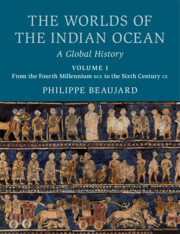Book contents
- The Worlds of the Indian Ocean
- The Worlds of the Indian Ocean
- The Worlds of the Indian Ocean
- Copyright page
- Dedication
- Epigraph
- Contents
- Maps and Charts (in color plates)
- Illustrations (in color plates)
- Figures
- Tables
- Abbreviations
- Preface
- Acknowledgments
- Prologue
- Introduction: The Geography of the Indian Ocean and Its Navigation
- Part I The Ancient Routes of Trade and Cultural Exchanges and the First States (Sixth–Second Millennium bce)
- Introduction
- Chapter 1 The Birth of the State
- Chapter 2 Early Bronze Age I in Western Asia and Egypt (c. 3000–2700 bce)
- Chapter 3 Early Bronze Age II (c. 2700–1950 bce)
- Chapter 4 The New Spaces of the Middle Bronze Age in Asia and Egypt (c. 2000–1750 bce)
- Chapter 5 The Late Bronze Age (c. 1600–1100 bce), an Area Unified around the Eastern Mediterranean
- Chapter 6 East Asia: From Villages to States (c. 5000–1027 bce)
- Chapter 7 The Emergence of Intermediary Spaces
- Conclusion Were there World-Systems during the Bronze Age?
- Part II The Birth of the Afro-Eurasian World-System (First Millennium bce – Sixth Century ce)
- Bibliography
- Index of Geographical names
- Name Index
- Subject Index
- Plate Section (PDF Only)
Chapter 4 - The New Spaces of the Middle Bronze Age in Asia and Egypt (c. 2000–1750 bce)
from Part I - The Ancient Routes of Trade and Cultural Exchanges and the First States (Sixth–Second Millennium bce)
Published online by Cambridge University Press: 04 October 2019
- The Worlds of the Indian Ocean
- The Worlds of the Indian Ocean
- The Worlds of the Indian Ocean
- Copyright page
- Dedication
- Epigraph
- Contents
- Maps and Charts (in color plates)
- Illustrations (in color plates)
- Figures
- Tables
- Abbreviations
- Preface
- Acknowledgments
- Prologue
- Introduction: The Geography of the Indian Ocean and Its Navigation
- Part I The Ancient Routes of Trade and Cultural Exchanges and the First States (Sixth–Second Millennium bce)
- Introduction
- Chapter 1 The Birth of the State
- Chapter 2 Early Bronze Age I in Western Asia and Egypt (c. 3000–2700 bce)
- Chapter 3 Early Bronze Age II (c. 2700–1950 bce)
- Chapter 4 The New Spaces of the Middle Bronze Age in Asia and Egypt (c. 2000–1750 bce)
- Chapter 5 The Late Bronze Age (c. 1600–1100 bce), an Area Unified around the Eastern Mediterranean
- Chapter 6 East Asia: From Villages to States (c. 5000–1027 bce)
- Chapter 7 The Emergence of Intermediary Spaces
- Conclusion Were there World-Systems during the Bronze Age?
- Part II The Birth of the Afro-Eurasian World-System (First Millennium bce – Sixth Century ce)
- Bibliography
- Index of Geographical names
- Name Index
- Subject Index
- Plate Section (PDF Only)
Summary
Following the global recession of the late third millennium, the beginning of the second millennium was a crucial period of transformation and expansion. The reunified Egypt of the Middle Kingdom (c. 2030–1730) extended its connections with the exchange networks of the eastern Mediterranean, a thriving region in this period. An urban civilization appeared in Crete (first Palatial Period), which invented particular systems of writing. Minoan networks expanded into the Aegean Sea, Greece, the Adriatic, and perhaps as far as the Black Sea. In western Asia, a phase of weaker central powers after the collapse of the Ur III Empire saw the new development of a system of city-states and the emergence – apparently in a new form – of the private sector, clearly visible in the functioning of the Assyrian trade in Anatolia.
- Type
- Chapter
- Information
- The Worlds of the Indian OceanA Global History, pp. 135 - 166Publisher: Cambridge University PressPrint publication year: 2019



